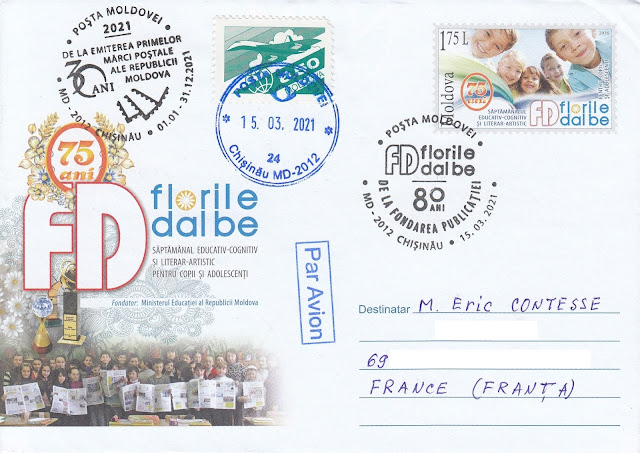TAD "80 ans du magazine Florile Dalbe" sur enveloppe pré-timbrée de Moldavie
Le 15 mars 2021, la poste moldave a mis en circulation un TAD consacré au 80ème anniversaire de la création de "Florile Dalbe", un magazine hebdomadaire éducatif-cognitif et littéraire-artistique pour enfants et adolescents ("Săptămânal educativ-cognitiv şi literar-artistic pentru copii şi adolescenţi"), publié en roumain à Chişinău.
Ce magazine a été publié entre 1941 et 1990 sous le titre "Tânărul leninist" ("Le jeune léniniste"), avant d'être rebaptisé "Florile Dalbe" ("Fleurs blanches") en 1990.
Ce magazine de culture générale est aujourd'hui l'une des publications les plus populaires pour les enfants et les adolescents de Moldavie, avec un tirage hebdomadaire entre 12000 et 15000 exemplaires.
La plupart des grandes figures du dessin/peinture et de la littérature moldave ont publiés dans ce magazine, comme les écrivains Grigore Vieru, Liviu Damian, Arhip Cibotaru, Vitalie Filip, Gheorghe Blănaru, Axentie Blanovschi, Gheorghe Gheorghiu, Mihail Ion Cibotaru, Filip Mironov, Gheorghe Marin, Victor Teleucă...
On March 15, 2021, the Post of Moldova put into circulation a postmark dedicated to the 80th anniversary of the creation of "Florile Dalbe", a weekly educational-cognitive and literary-artistic magazine for children and adolescents ("Săptămânal educativ-cognitiv şi literar-artistic pentru copii şi adolescenţi"), published in Romanian in Chişinău.
This magazine was published from 1941 to 1990 under the title "Tânărul leninist" ("The Young Leninist"), before being renamed "Florile Dalbe" ("White Flowers") in 1990.
This general culture magazine is today one of the most popular publications for children and adolescents in Moldova, with a weekly print run between 12,000 and 15,000 copies.
Most of the great figures of Moldovan drawing/painting and literature have published in this magazine, such as writers Grigore Vieru, Liviu Damian, Arhip Cibotaru, Vitalie Filip, Gheorghe Blănaru, Axentie Blanovschi, Gheorghe Gheorghiu, Mihail Ion Cibotaru, Filip Mironov, Gheorghe Marin, Victor Teleucă ...
Ce TAD, conçu par Maria Maximenco, a été appliqué par le bureau
principal de Chişinău (MD-2012) sur cette enveloppe pré-timbrée (1,75 L,
tirage : 20000, conception : Vitaliu Pogolșa), mise en circulation le 1er juin 2016 à l'occasion du 75ème anniversaire de la création de ce même magazine "Florile Dalbe". Merci beaucoup Nicolae !
Le timbre à 8,50 roubles (puis 8,50 L depuis le 1er février 2006) fait partie d'une série de 4 timbres émise le 20 juillet 1992, représentant un même motif d'avion supersonique, avec des couleurs différentes.
A
noter cet autre TAD spécial (conception : Maria Maximenco), appliqué
sur cette enveloppe, mis en circulation pendant toute l'année 2021 à
l'occasion
des 30 ans de l'émission des premiers timbres par la République de Moldavie.
This
postmark, designed by Maria Maximenco, was applied by the main post
office in Chişinău (MD-2012) on this prepaid envelope (1.75 L, print
run: 20,000, design: Vitaliu Pogolșa), put into circulation on June 1, 2016 on the occasion of the 75th anniversary of the creation of this same magazine "Florile Dalbe". Thank you very much Nicolae!
The 8.50 rubles stamp (value of L 8.50 from February 1, 2006) is part of a series of four stamps issued on July 20, 1992, depicting the same
supersonic aircraft, with different colors.
To
note this other special postmark (design: Maria Maximenco), applied on
this envelope, put into circulation throughout 2021 on the occasion of
the 30th anniversary of the issue of the first stamps by the Republic of Moldova.

























